
Sam Sewall, Research Executive, The Nielsen Company
SUMMARY: On June 12, 2009, the Federal Communications Commission (FCC) mandated that all U.S. based television signals must be transmitted digitally. The great majority of U.S. households (97.5%) were prepared for the digital transition in the week prior to the power turn-off. Nielsen data shows unprepared homes were more likely to be minorities, younger, lower income, and were less likely to have Internet access. Most homes acquired a digital converter box to make their television ready for the change.
On June 12, 2009, the FCC required all high-power analog U.S. television stations to turn off their signals and move to a digital-only transmission. A review of the process—and progress—as television households became ready for the analog shut-off reveals the audience impact on stations that shut off their analog signals.
By the time the June 12 deadline arrived, most U.S. homes were ready for the conversion to digital. There was a sharp decline in the number of completely unready homes (just 2.5% of U.S. households) for the digital transition in the week leading up to the digital transition. And as of October 4, that number was reduced to 0.5%. Those homes that were completely unready were more likely to be African American, Hispanic, Asian, younger, lower income, and were less likely to have Internet access.
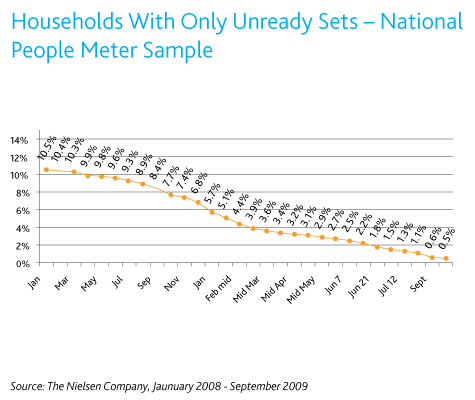
By the end of August, almost three-quarters of unready homes made the switch to digital TV via a digital converter box, 18.2% acquired a cable subscription, and 7.5% received DBS (direct broadcast satellite). The lower income status of completely unready homes likely led them to the federally funded converter box coupon program instead of subscribing to cable or DBS.
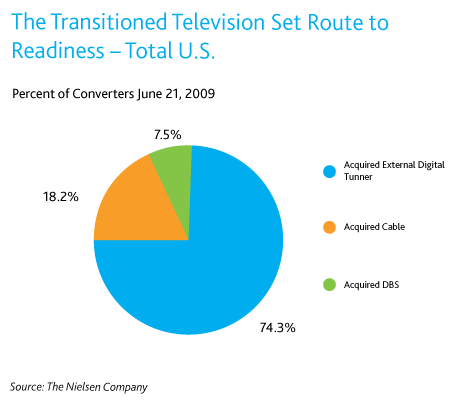
In general, unready homes represented just 1–2% of total television tuning before the June 12th transition. Television sets that were not ready for the digital transition were viewed about one-third of the time compared to ready sets. Unready sets were viewed 1.5 hours a day on average, while ready sets were viewed 5.1 hours per day. And in the week leading up to the analog shut off, almost 60% of unready sets had no television tuning at all.
Unready sets were typically found in rooms that are not focal points of television viewing, such as secondary bedrooms, kitchens and other locations. The location of these sets corresponds to the fact that they were used less for television viewing.
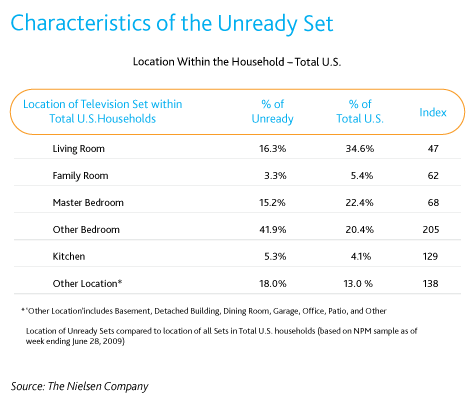
Surprisingly, the age profile of unready homes skewed younger than Total U.S. figures. More than half of viewers from completely unready households were under the age of 35—a stark comparison to Total U.S. statistics, where roughly one-third of consumers make up this age cohort. And unready homes were less than half as likely to be over 55 years as the audience in Total U.S. homes.
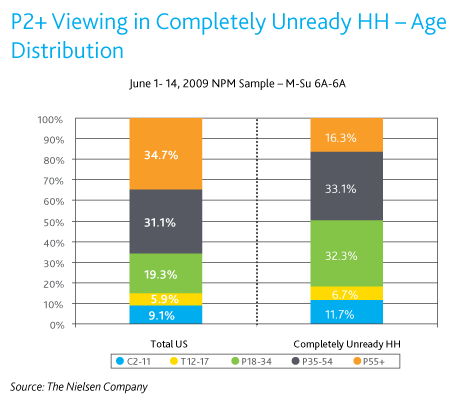
In total, TV stations that transitioned to digital only experienced an 8% share decline immediately following the analog shut-off. Half of that decline is attributed to a loss of tuning from homes that were completely unready for the digital transition. Additionally, 13% of the prior audience to these stations came from homes with at least one unready set and one ready set. It is likely that the stations lost some audience from these partially-unready homes as well.
Stations that changed channel positions from UHF (ultra high frequency) to VHF (very high frequency) were more impacted, showing a 13% share decline. This change in channel position created challenges in household receivability, since homes with “digital” antennas—which were only capable of receiving UHF signals—were not able to receive VHF digital signals and homes could not receive these channels without performing a re-scan of their converter boxes.
Audience loss from unready set tuning was higher for Spanish-Language broadcast networks than for English-language networks. Immediately prior to the analog shut off, 3% of all people viewing English-language national broadcast networks came from unready sets. That figure tripled for Spanish-language broadcast networks, where 9% of the ratings came from unready sets.
These audience declines were also likely impacted by seasonality—not just the digital transition. Nielsen data shows that TV viewing typically goes down in the summer months. A review of prior years confirms this dip in viewing levels at this same point in the television season.
For the first two weeks following the analog shut-off, transitioning station shares were 8.4% lower than they were in the two weeks prior to transition. In the third and fourth week following the transition, the shares to transitioning stations were 9.3% lower than the pre-transition period.
Based on historical seasonality trends, there is an expectation that stations would have experienced share declines of about 2.4% to 3.6% in the weeks following June 12, 2009. Therefore, the additional 4.1% to 6.1% decline actually experienced in the two weeks following the digital transition is approximately the range of share decline attributable to the digital transition. As the date moves further out from the transition, more of the station declines are attributable to seasonal trends, as the chart below indicates.
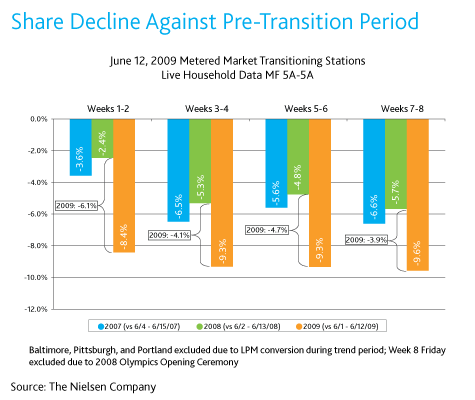
The digital future
With super sharp high-definition programming and the ability to show multiple standard definition digital programs simultaneously, digital programming offers many advantages over analog television for viewing broadcast TV. Homes are now capable of receiving more channels than ever before. And a review of pre- and post-transition audience shares to non-simulcast digital sub channels following June 12 show an increase—albeit modest. Nielsen will continue to track growth in these digital sub channels.
As the analog shut-off date becomes more distant, the trends in 2009 are moving closer to the 2007 and 2008 trends—a clear indication that homes are adapting to the new digital landscape and continuing to find their TV content.



